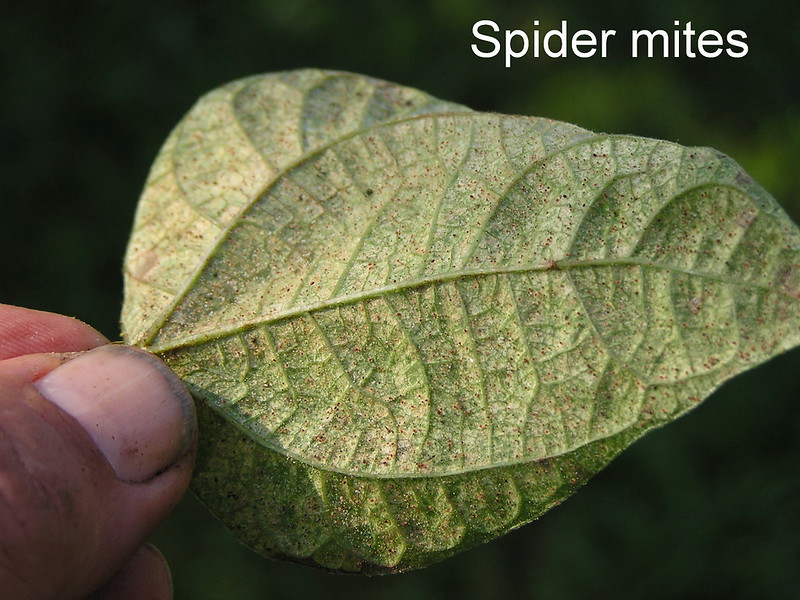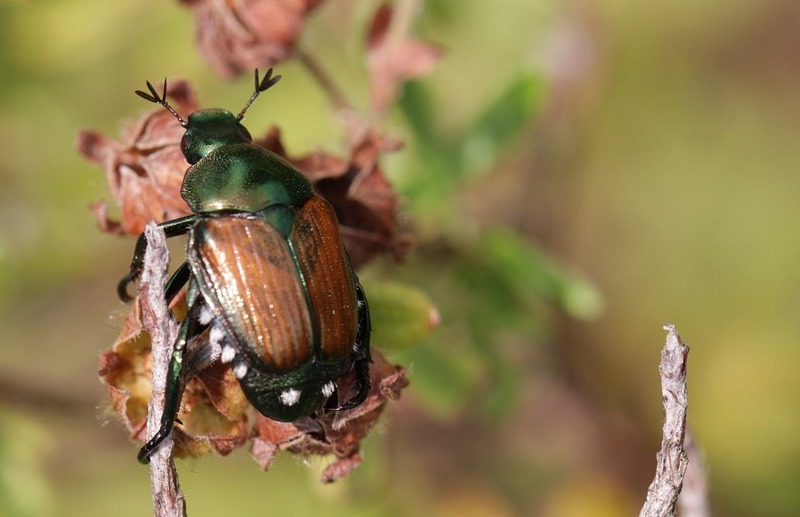Chinese fringe flower, known scientifically as Loropetalum, is fairly disease and pest resistant. In fact, there are few insects, gastropods, or mammals that attack this delightful shrub. The most common problems from pests involve sap-sucking insects and, in some parts of the United States, yearly outbreaks of Japanese beetles. All of these pests can be easily controlled to reduce the damage to your garden and shrubs.
Common Loropetalum Pests
Aphids
Aphids come in many different colors and are known by many common names regionally. Loropetalum is most likely to be attacked by white, green, or black aphids, which are also known as whitefly, blackfly, and greenfly. These insects are sap suckers that feed on plant leaves and stems, removing the nutrients a plant needs for photosynthesizing and other processes. Many generations of aphids are produced during a growing season, and the eggs often overwinter on the plant, reinfecting the next year's growth.
If plants are not treated, the overall vigor of a plant can decline as the aphid populations increase. Young or tender plants are more likely to succumb to aphids. More mature trees and shrubs usually withstand damage for many years. Heavy infestations of aphids also lead to secondary attacks from ants, drawn to the aphid’s honeydew, along with fungal diseases down the road.
Treating Aphids on Loropetalum
The quickest way to get rid of aphids is by washing them off the leaves with a blast of water. This drowns the insects and knocks them off the plants. Repeat the spraying every few days until no more aphids remain on the plant. Aphids are also prey for beneficial predators such as lady beetles and their larvae, syrphid flies, and lacewing flies. Allowing these predators to take up residence in parts of the garden will encourage a healthy ecosystem.
The last resort against an aphid infestation should be an insecticidal soap spray formulated for use on Loropetalum shrubs. The soft bodies of aphids have no exoskeleton, allowing the soap to soak in and kill them. Remove any damaged plant material and dispose of it once the aphids are under control.
Preventing Aphids on Loropetalum
Proper pruning and watering techniques are key to keeping aphids at bay. Quick-growing, dense foliage as a result of overfertilizing is often very weak because the plant does not have a big enough root system for support.
Aphids can sense this weakness in some plants and will attack seemingly from nowhere. Keep shrubs pruned adequately to increase air circulation around and through the shrubs. Do not over or underwater your shrubs. Either will stress the plants and invite infestation. Encourage beneficial predators into your yard by planting host plants, providing nesting and overwintering sites and not using broad-spectrum chemicals which kill both harmful pests and the beneficials.
Spider Mites
Spider Mites are more likely to attack during periods of dry and hot weather. These sap-sucking insects can be red, brown, or black, and are often smaller than the size of a pen tip. Early infestations may not be visible until the mites spin webs on the undersides of leaves and between small stems. The mites suck sap from the leaves, causing them to stipple. The leaves will begin to turn yellow, die, and fall off the plant. Repeated attacks can cause a serious decline in the growth and flowering of Loropetalum.
Female mites overwinter on the plants or in leaf litter at the base of the plants. As soon as the weather is warm and dry enough in late spring, the females begin to lay eggs for the next generation.

Photo by Scot Nelson
Treating Spider Mites on Loropetalum
Horticultural soap spray will help to control an infestation of spider mites. Many applications may be needed to get the pest under control. Always follow the label instructions and make sure that the spray is specifically listed for use on Loropetalum and spider mites. Many beneficial predators, such as minute pirate bugs, lacewings, and lady beetles feed on spider mites and can quickly reduce an outbreak. Remove any affected foliage or stems to ensure that no spider mites overwinter in your shrubs.
Preventing Spider Mites on Loropetalum
Spider mites only attack during hot, dry weather and target stressed plants. Resist the urge to over-fertilize plants in the garden. High-nitrogen feeds will boost leafy growth without strengthening the root structure of a plant. The extra top growth will be weak and susceptible to attack from many pests. Remove any leaf litter to prevent overwintering female mites.
Encouraging beneficial insects to live in your garden is the number one way to reduce the chance of a large outbreak of spider mites. The beneficial predators keep pest populations low. The use of broad-spectrum pesticides can harm all insects in the garden, beneficial or not. Using less harmful preparations such as horticultural soaps and oils at the right time of the day will protect beneficial allies in the garden.
Japanese Beetles
Japanese Beetles are an annual pest that plagues gardeners mainly in the east and Midwest of the United States. This invasive pest was brought to the United States in 1916 on a cargo ship from Japan, where there are many natural predators to keep the pest in check. The shiny green and copper beetles are voracious eaters of most ornamental plants and edible crops and feed for 40-45 days while they are busy laying eggs for the next year's generation.
The eggs are laid in lawns, especially those that are well manicured and fertilized. Outbreaks typically start around the end of June and continue through the end of July, until all of the adults have laid eggs and died off. Plant leaves are often skeletonized and the flowers are destroyed beyond repair. Mature shrubs and trees are more likely to survive a heavy infestation of Japanese beetles. Perennials and annuals often have to be cut back entirely or removed.

Treating Japanese Beetles on Loropetalum
Protect Loropetalum from damage by using a fine mesh cover or horticultural bug fabric. Temporarily secure the cover when an outbreak is normally expected. Do not remove it until well after all of the beetles have died off. Repellent and protective sprays are also available, although they require frequent reapplication, especially after heavy rains.
Japanese beetle traps work so well that you run the risk of attracting more beetles to your garden without proper placement. The traps contain a pheromone to attract Japanese beetles. There is no way for the beetle to escape the trap, and it eventually dies. Place the traps far away from the plants that you would like to protect or else they will become the Japanese beetle's last meal.
Preventing Japanese Beetles on Loropetalum
The best prevention for Japanese beetles is to destroy the grubs that hatch in your lawn. The creamy white grubs are active in the fall and spring, eating the roots of your turf after they hatch. In June, the grubs pupate into the beetles, which destroy many garden plants. Using either beneficial nematodes or Milky Spore as a soil drench will target the grubs and reduce populations of the Japanese beetles in your yard.
Follow the label directions very closely because both treatments need to be applied during periods of warm, but not hot, weather while the grubs are active.
Loropetalum Pests Chart
|
Pest |
Identifying |
Treating |
|
Aphids |
Small, soft-bodied insects, usually less than 1/8 inch long, with pear-shaped bodies |
Wash them off the leaves with a blast of water |
|
Spider Mites |
Sap-sucking insects can be red, brown, or black, often smaller than the size of a pen tip |
Spray with horticultural soap |
|
Japanese Beetles |
Metallic green beetles with coppery-brown wing cover |
Use a fine mesh cover or horticultural bug fabric |
Sources: "Loropetalum chinense." The North Carolina Extension Gardener Plant Toolbox. plants.ces.ncsu.edu
 |
Author Robbin Small - Published 6-06-2023 |
